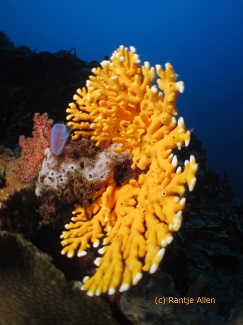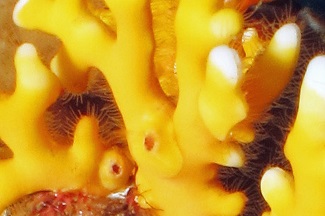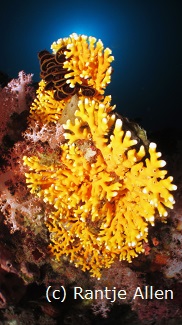Loading content - please wait...
Yellow lace coral lives deep down
Yellow lace coral thrives below thirty meters in Gorontalo. Its bold honey-lemon hue adds distinctive color to deep reefs where ambient light is low.
Not a Reef Building Coral
Although they have some similarities, lace corals are not fire corals. Millepora fire coral species have symbiotic algae living inside their tissues. These algae contribute nutrients and color to fire corals, as well as reef building corals.
However
, lace corals are hydrocorals. Their skeleton is made of calcium and can easily break. Its tiny polyp pores are minute with diameters less than one millimeter. Lace corals have two genus, Stylaster and Distichopora. They lack symbiotic algae. This means that the distinctive colors of lace corals are part of their skeletons. Whereas other coral skeletons turn white when the colony dies, lace corals retain their coloration even after death.Yellow Lace Coral & Deep Reefs
Divers in Gorontalo who venture down to thirty meters can easily spot Yellow lace corals on certain dive sites. These corals look like yellow fans. Sometimes, a colony has more than one fan from the single base. The branches are stout and rounded. Gorontalo’s Yellow lace corals have tips of white. They are found on vertical surfaces and tucked into small holes or crevasses.
The Yellow lace coral could be Distichopora violacea, despite not being purple. There are 34 named species of Distichopora, but many remain unnamed. They are only found in Pacific oceans, including Tomini Bay where we dive.
Tiny, Stinging Hairs
Like other Distichopora species but unlike reef building corals, our Yellow lace coral has different types of polyps. All connect via canals inside the yellow skeleton where they are imbedded. These microscopic polyps have different functions. Two types protrude from the skeleton. They are gastropores and dactylopores.
The dactylopores have fine hairs that possess stinging cells called nematocysts. They can leave stings on divers who touch or brush against them. The function of these cells is to sting plankton. The stunned plankton are then eaten by gastropores, which contain the feeding polyps.
Complex Reproduction of Lace Corals
Although reproduction among reef building corals is relatively straightforward, that of lace corals is not. Lace coral polyps release medusae, which look like microscopic jellyfish. These medusae possess both male and female reproductive organs. These in turn release eggs and sperm into the ocean. A fertilized egg will develop into a larvae that swims until it reaches a hard surface. There is will attach and form a new lace coral colony.
Lace corals can also reproduce by fragmentation. For your chance to see Gorontalo’s deep water Yellow lace coral, please make your dive reservations directly with Miguel’s Diving.









Sorry, comments are closed for this post.